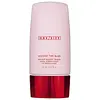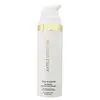What's inside
What's inside
 Key Ingredients
Key Ingredients

 Benefits
Benefits

 Concerns
Concerns

 Ingredients Side-by-side
Ingredients Side-by-side

Water
Skin ConditioningPolysilicone-11
Propanediol
SolventSilica
AbrasiveDimethicone
EmollientC15-19 Alkane
SolventDicaprylyl Carbonate
EmollientDimethicone/Vinyl Dimethicone Crosspolymer
Skin ConditioningGlycerin
HumectantGlyceryl Stearate Citrate
EmollientNiacinamide
SmoothingSodium Polyacrylate
AbsorbentHamamelis Virginiana Water
AstringentPhenoxyethanol
PreservativePvp
Emulsion StabilisingPullulan
Hydroxyacetophenone
AntioxidantLaureth-12
EmulsifyingEthylhexylglycerin
Skin ConditioningHdi/Trimethylol Hexyllactone Crosspolymer
Polymethylsilsesquioxane
Zingiber Officinale Root Extract
MaskingWater, Polysilicone-11, Propanediol, Silica, Dimethicone, C15-19 Alkane, Dicaprylyl Carbonate, Dimethicone/Vinyl Dimethicone Crosspolymer, Glycerin, Glyceryl Stearate Citrate, Niacinamide, Sodium Polyacrylate, Hamamelis Virginiana Water, Phenoxyethanol, Pvp, Pullulan, Hydroxyacetophenone, Laureth-12, Ethylhexylglycerin, Hdi/Trimethylol Hexyllactone Crosspolymer, Polymethylsilsesquioxane, Zingiber Officinale Root Extract
Water
Skin ConditioningIsodecyl Neopentanoate
EmollientGlycerin
HumectantTalc
AbrasiveOctyldodecanol
EmollientDimethicone
EmollientGlyceryl Stearate Citrate
EmollientHydroxyethyl Acrylate/Sodium Acryloyldimethyl Taurate Copolymer
Emulsion StabilisingMica
Cosmetic ColorantPhenoxyethanol
PreservativePolyacrylate-21
Dimethicone/Vinyl Dimethicone Crosspolymer
Skin ConditioningGlyceryl Stearate
EmollientSodium Polyacrylate
AbsorbentCaramel
Cosmetic ColorantEthylhexylglycerin
Skin ConditioningTocopheryl Acetate
AntioxidantChlorphenesin
AntimicrobialSodium Hydroxide
BufferingSqualane
EmollientSilica
AbrasiveAllantoin
Skin ConditioningCamellia Oleifera Seed Oil
Skin ConditioningPolysorbate 60
EmulsifyingSodium Acrylates Copolymer
Sorbitan Isostearate
EmulsifyingButylene Glycol
HumectantCaprylyl Glycol
EmollientLecithin
EmollientNiacinamide
SmoothingDipropylene Glycol
HumectantCitrus Grandis Peel Oil
MaskingGlyceryl Caprylate
EmollientSodium Hyaluronate
HumectantHydrolyzed Algin
Solanum Lycopersicum Leaf Cell Culture Extract
Skin ConditioningLimonene
PerfumingTin Oxide
AbrasiveCI 77891
Cosmetic ColorantCI 77491
Cosmetic ColorantWater, Isodecyl Neopentanoate, Glycerin, Talc, Octyldodecanol, Dimethicone, Glyceryl Stearate Citrate, Hydroxyethyl Acrylate/Sodium Acryloyldimethyl Taurate Copolymer, Mica, Phenoxyethanol, Polyacrylate-21, Dimethicone/Vinyl Dimethicone Crosspolymer, Glyceryl Stearate, Sodium Polyacrylate, Caramel, Ethylhexylglycerin, Tocopheryl Acetate, Chlorphenesin, Sodium Hydroxide, Squalane, Silica, Allantoin, Camellia Oleifera Seed Oil, Polysorbate 60, Sodium Acrylates Copolymer, Sorbitan Isostearate, Butylene Glycol, Caprylyl Glycol, Lecithin, Niacinamide, Dipropylene Glycol, Citrus Grandis Peel Oil, Glyceryl Caprylate, Sodium Hyaluronate, Hydrolyzed Algin, Solanum Lycopersicum Leaf Cell Culture Extract, Limonene, Tin Oxide, CI 77891, CI 77491
Ingredients Explained
These ingredients are found in both products.
Ingredients higher up in an ingredient list are typically present in a larger amount.
Dimethicone is a type of synthetic silicone created from natural materials such as quartz.
What it does:
Dimethicone comes in different viscosities:
Depending on the viscosity, dimethicone has different properties.
Ingredients lists don't always show which type is used, so we recommend reaching out to the brand if you have questions about the viscosity.
This ingredient is unlikely to cause irritation because it does not get absorbed into skin. However, people with silicone allergies should be careful about using this ingredient.
Note: Dimethicone may contribute to pilling. This is because it is not oil or water soluble, so pilling may occur when layered with products. When mixed with heavy oils in a formula, the outcome is also quite greasy.
Learn more about DimethiconeThis ingredient is a silicone used to improve the texture of products and absorb oil. It does not get absorbed into the skin.
Like other silicones, Dimethicone/Vinyl Dimethicone Crosspolymer helps condition the skin by creating a barrier. In this sense, it can act as an emollient and trap moisture in.
This ingredient is a type of elastomer.
Learn more about Dimethicone/Vinyl Dimethicone CrosspolymerEthylhexylglycerin (we can't pronounce this either) is commonly used as a preservative and skin softener. It is derived from glyceryl.
You might see Ethylhexylglycerin often paired with other preservatives such as phenoxyethanol. Ethylhexylglycerin has been found to increase the effectiveness of these other preservatives.
Glycerin is already naturally found in your skin. It helps moisturize and protect your skin.
A study from 2016 found glycerin to be more effective as a humectant than AHAs and hyaluronic acid.
As a humectant, it helps the skin stay hydrated by pulling moisture to your skin. The low molecular weight of glycerin allows it to pull moisture into the deeper layers of your skin.
Hydrated skin improves your skin barrier; Your skin barrier helps protect against irritants and bacteria.
Glycerin has also been found to have antimicrobial and antiviral properties. Due to these properties, glycerin is often used in wound and burn treatments.
In cosmetics, glycerin is usually derived from plants such as soybean or palm. However, it can also be sourced from animals, such as tallow or animal fat.
This ingredient is organic, colorless, odorless, and non-toxic.
Glycerin is the name for this ingredient in American English. British English uses Glycerol/Glycerine.
Learn more about GlycerinGlyceryl Stearate Citrate is a citric acid ester of glyceryl stearate.
It is an emulsifier, emollient, and a surfactant.
Emulsifiers help stabilize a product. It does this by preventing certain ingredients from separating. Common ingredients include oils and water, which do not mix naturally. Emulsifiers have properties that help keep ingredients such as these together.
Emollients help soothe and soften the skin. They do this by creating a protective film on your skin. This barrier helps trap moisture and keeps your skin hydrated. Emollients may be effective at treating dry or itchy skin.
Surfactants help gather oils, dirt, and other pollutants from the skin. This helps them to be easily rinsed away.
Learn more about Glyceryl Stearate CitrateNiacinamide is a multitasking form of vitamin B3 that strengthens the skin barrier, reduces pores and dark spots, regulates oil, and improves signs of aging.
And the best part? It's gentle and well-tolerated by most skin types, including sensitive and reactive skin.
You might have heard of "niacin flush", or the reddening of skin that causes itchiness. Niacinamide has not been found to cause this.
In very rare cases, some individuals may not be able to tolerate niacinamide at all or experience an allergic reaction to it.
If you are experiencing flaking, irritation, and dryness with this ingredient, be sure to double check all your products as this ingredient can be found in all categories of skincare.
When incorporating niacinamide into your routine, look out for concentration amounts. Typically, 5% niacinamide provides benefits such as fading dark spots. However, if you have sensitive skin, it is better to begin with a smaller concentration.
When you apply niacinamide to your skin, your body converts it into nicotinamide adenine dinucleotide (NAD). NAD is an essential coenzyme that is already found in your cells as "fuel" and powers countless biological processes.
In your skin, NAD helps repair cell damage, produce new healthy cells, support collagen production, strengthen the skin barrier, and fight environmental stressors (like UV and pollution).
Our natural NAD levels start to decline with age, leading to slower skin repair, visible aging, and a weaker skin barrier. By providing your skin niacinamide, you're recharging your skin's NAD levels. This leads to stronger, healthier, and younger looking skin.
Another name for vitamin B3 is nicotinamide. This vitamin is water-soluble and our bodies don't store it. We obtain Vitamin B3 from either food or skincare. Meat, fish, wheat, yeast, and leafy greens contain vitamin B3.
The type of niacinamide used in skincare is synthetically created.
Learn more about NiacinamidePhenoxyethanol is a preservative that has germicide, antimicrobial, and aromatic properties. Studies show that phenoxyethanol can prevent microbial growth. By itself, it has a scent that is similar to that of a rose.
It's often used in formulations along with Caprylyl Glycol to preserve the shelf life of products.
Silica, also known as silicon dioxide, is a naturally occurring mineral. It is used as a fine, spherical, and porous powder in cosmetics.
Though it has exfoliant properties, the function of silica varies depending on the product.
The unique structure of silica enhances the spreadability and adds smoothness, making it a great texture enhancer.
It is also used as an active carrier, emulsifier, and mattifier due to its ability to absorb excess oil.
In some products, tiny microneedles called spicules are made from silica or hydrolyzed sponge. When you rub them in, they lightly polish away dead skin layers and enhance the penetration of active ingredients.
Learn more about SilicaSodium Polyacrylate is the sodium salt of polyacrylic acid. It is used as an absorber, emollient, and stabilizer.
This ingredient is a super-absorbent polymer - meaning it can absorb 100 to 1000 times its mass in water. As an emollient, Sodium Polyacrylate helps soften and soothe skin. Emollients work by creating a barrier to trap moisture in. This helps keep your skin hydrated.
Water. It's the most common cosmetic ingredient of all. You'll usually see it at the top of ingredient lists, meaning that it makes up the largest part of the product.
So why is it so popular? Water most often acts as a solvent - this means that it helps dissolve other ingredients into the formulation.
You'll also recognize water as that liquid we all need to stay alive. If you see this, drink a glass of water. Stay hydrated!
Learn more about Water